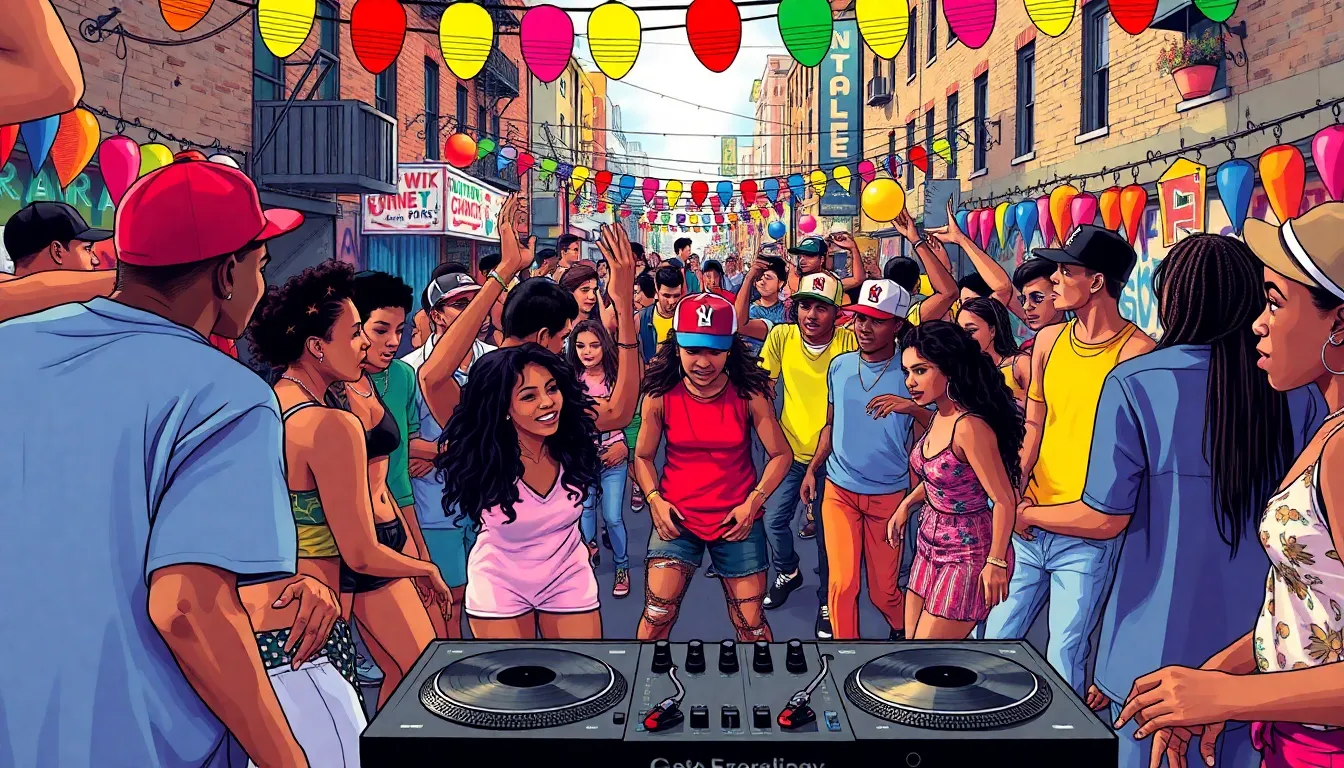Hip-hop isn’t just a genre; it’s a vibrant community that’s reshaped culture and society. From the block parties of the Bronx to global stages, it’s a movement fueled by creativity, resilience, and a whole lot of rhythm. With its roots in storytelling, hip-hop connects people through shared experiences and diverse voices, proving that sometimes the best way to express yourself is through a killer beat and clever lyrics.
But let’s be real: the hip-hop community is as complex as a double entendre. It’s a melting pot of talent, passion, and a sprinkle of friendly competition. Whether you’re a die-hard fan or just curious about what makes this culture tick, there’s always something new to discover. So grab your headphones and get ready to dive into a world where every rhyme tells a story and every dance move has a history.
Table of Contents
ToggleOverview of the Hip-Hop Community
The hip-hop community encompasses diverse elements, including music, dance, art, and fashion. Originating in the Bronx during the 1970s, it emerged as a grassroots movement reflecting the experiences of marginalized groups. Participants express themselves through various forms, contributing to a rich tapestry of creativity that resonates globally.
Artists play a pivotal role in the community. Rappers, DJs, and producers collaborate to produce innovative sounds, while dancers and graffiti artists contribute vital visual dimensions. This interconnectedness fosters a sense of belonging among individuals who share similar backgrounds or aspirations.
Competitions and battles define the culture, showcasing talent and skill. Events, such as rap battles and breakdancing contests, encourage participants to elevate their craft while engaging audiences. Community gatherings often celebrate this talent, strengthening connections among members.
Furthermore, social activism is a cornerstone of hip-hop. Many artists use their platforms to address societal issues like inequality and injustice. Their messages resonate with listeners, inspiring change and instigating conversations about critical topics.
Today, the hip-hop community continues to evolve. New genres and subcultures emerge, reflecting shifting societal dynamics. Social media platforms and streaming services allow artists to reach wider audiences, democratizing access to hip-hop culture.
Inclusivity remains a key principle. The community invites individuals from various backgrounds and experiences to engage and contribute. This openness ensures hip-hop stays vibrant and relevant, fostering an ever-growing network of artists and fans alike.
Historical Background

Hip-hop emerged as a cultural movement in the 1970s, deeply rooted in the experiences of marginalized communities. This vibrant community stands out for its creativity and resilience.
Origins of Hip-Hop
Hip-hop originated in the Bronx, New York City, where young people sought an expressive outlet amidst socio-economic challenges. DJ Kool Herc played a vital role by introducing break beats, transforming the way music was experienced. Block parties became popular, allowing local artists to showcase their talents, fostering a sense of community. Through this grassroots movement, members shared their stories and built connections, leading to the birth of a new cultural movement.
Key Figures in Early Hip-Hop
Prominent figures shaped the early hip-hop scene, including Grandmaster Flash and Afrika Bambaataa. Grandmaster Flash revolutionized DJing by developing techniques like backspinning, creating a distinct sound. Afrika Bambaataa’s Universal Zulu Nation promoted peace, unity, and community engagement, further enriching hip-hop’s cultural significance. Additionally, The Sugarhill Gang introduced hip-hop to mainstream audiences with the hit “Rapper’s Delight,” broadening the genre’s reach and popularity. These artists laid the groundwork for future generations, establishing hip-hop as a powerful voice for social change.
Cultural Impact
Hip-hop profoundly shapes various cultural landscapes, influencing music, art, and social movements. The community’s reach extends beyond entertainment, rendering it a powerful force in contemporary society.
Influence on Music and Art
Hip-hop revolutionized music through its innovative beats and lyrical depth. Rappers and producers continually push boundaries, blending genres like jazz, rock, and electronic into their work. Artists such as Kendrick Lamar and Cardi B exemplify this evolution, earning critical acclaim and commercial success. Street art and graffiti also thrive within this culture, with artists like Banksy and Jean-Michel Basquiat drawing inspiration from hip-hop. The integration of dance styles, particularly breakdancing and street dance, enriches the artistic complexity of this movement.
Social Justice and Activism
Artists often utilize their platforms to address pressing social issues. Many hip-hop figures, including Nipsey Hussle and Common, engage in activism, spotlighting topics like police brutality and systemic inequality. Lyrics frequently serve as a conduit for important conversations about race and justice. Organizations linked to hip-hop, such as the Hip Hop Caucus, mobilize communities to advocate for change. This commitment to social justice underscores the community’s role as a catalyst for awareness and action within society.
Contemporary Trends
Contemporary hip-hop showcases diverse trends that reflect its dynamic nature. Artists continually innovate, creating varied styles that resonate with a global audience.
Evolution of Hip-Hop Styles
New subgenres emerge regularly, adapting to cultural shifts and technological advancements. Trap music, characterized by its heavy bass and hi-hats, gained popularity in the 2010s with artists like Migos and Future. Drill music, originating from Chicago, features dark, aggressive beats and raw lyrics, influencing artists worldwide such as Chief Keef and Pop Smoke. Moreover, conscious rap remains vital, addressing societal issues with thoughtful lyrics, exemplified by artists like J. Cole and Kendrick Lamar. Styles evolve through collaboration, blending influences from R&B, electronic, and pop genres, making hip-hop a continually evolving force in music.
Role of Digital Media
Digital media reshapes how hip-hop is created, distributed, and consumed. Social media platforms allow artists to connect directly with fans, enabling real-time feedback and interaction. Streaming services, like Spotify and Apple Music, democratize music access, allowing emerging artists to gain visibility alongside established names. Visual platforms like TikTok and Instagram have transformed music promotion, as viral challenges and trends can launch songs to new heights. Content sharing encourages diverse expression, with visual art and dance influencing musical styles and vice versa. Digital media fosters collaboration, blurring the lines between various art forms within the hip-hop community.
Challenges Facing the Hip-Hop Community
The hip-hop community faces significant challenges that impact its growth and representation.
Representation and Diversity
Inequities in representation characterize the hip-hop scene. Many marginalized groups within communities often lack visibility in mainstream media. Female artists frequently encounter additional barriers, including sexism and reduced opportunities. Moreover, artists of color navigate systemic obstacles that limit their exposure. Diverse voices such as those from the LGBTQ+ community also seek acknowledgment and acceptance. While progress occurs, continued efforts are essential to ensure a more inclusive environment where varied narratives thrive.
Commercialization of Hip-Hop
The commercialization of hip-hop presents another pressing challenge. Corporate interests increasingly influence the direction of the genre, often prioritizing profit over authenticity. Mainstream success frequently shapes perceptions of what constitutes “real” hip-hop, sidelining underground talent. This commercialization can dilute cultural messages, focusing instead on marketability. Independent artists strive to maintain their artistic integrity amidst these pressures, seeking platforms that support genuine expression. The balance between commercial success and authentic artistry remains a critical discussion within the community.
The hip-hop community stands as a testament to the power of creativity and resilience. It thrives on the shared experiences of individuals who contribute to its rich tapestry. As it continues to evolve, the community embraces new voices and styles while addressing pressing social issues.
Despite facing challenges like representation and commercialization, hip-hop remains a vibrant force for change. Artists are redefining the boundaries of the genre, ensuring its relevance in today’s society. The ongoing dialogue within the community fosters inclusivity and encourages exploration, making hip-hop a dynamic cultural movement that resonates across generations.


